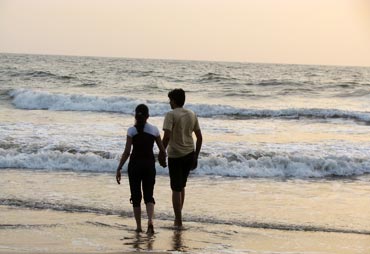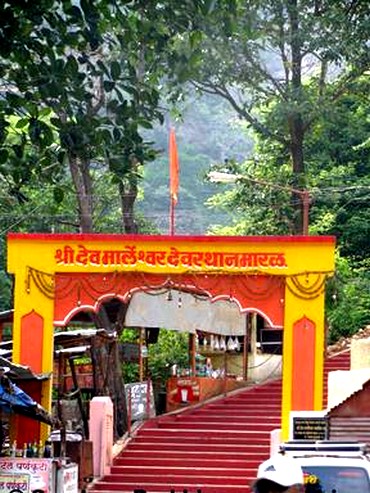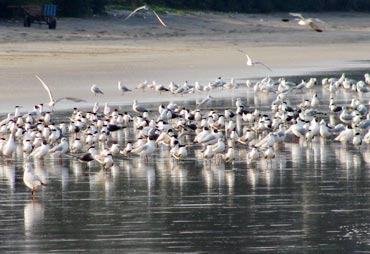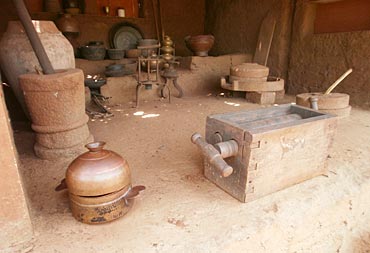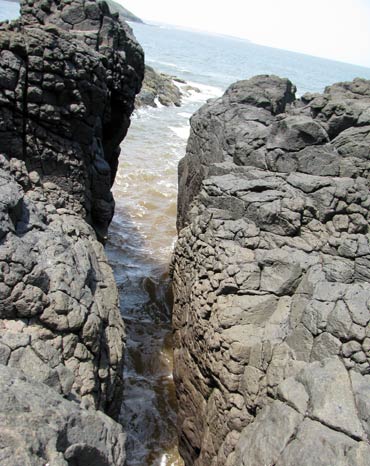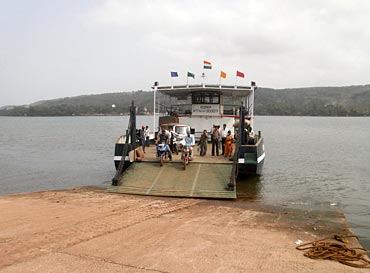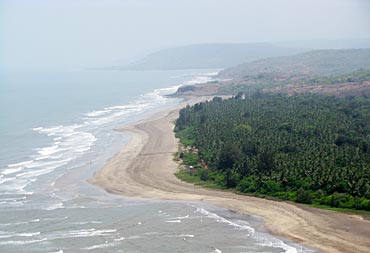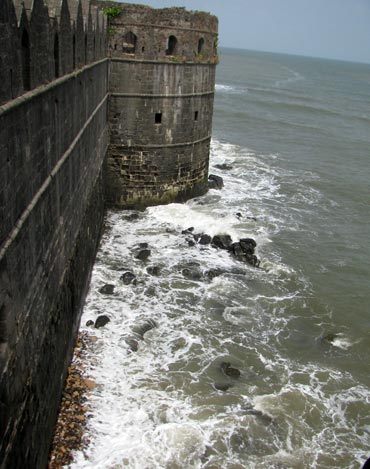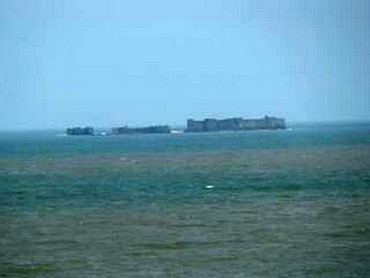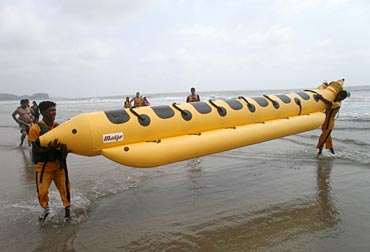 | « Back to article | Print this article |
IN PICS: Road trip in Konkan
Rediff reader Sandeep Parkhi shares with us this travel diary of the road trip he recently took to the Konkan region of Maharashtra.
For the last few years, we had been planning a Konkan tour without much success.
My wife hadn't seen the sea in her lifetime and I was reluctant to take her to any of the Mumbai beaches because I didn't want her first impression about the sea and beaches to be bad.
Suddenly in April this year we had the opportunity to visit Konkan and we grabbed it with both hands!
About Konkan
Konkan is the hilly area along the western coastline of India, with Arabian Sea on one side and Sahyadri mountain ranges on the other side.
It starts from Thane District near Mumbai and goes southwards up to Mangalore District in Karnataka.
However most Maharashtrians feel that Konkan starts from Thane District and ends at Sindhudurg District.
The legend goes that Parashuram created the beautiful land of Konkan by reclaiming it from the sea and it is the Karmabhumi of Lord Parashuram, the sixth avatar of Vishnu.
It is also called as the California of India, famous for the produce of Alphonso mangoes and a land with rich mineral resources, a land of landscapes, carpeted with tropical forest, a land of coconut, betel nut, cashew, jack fruit, tamarind, bamboo etc.
Konkan receives heavy rainfall during the monsoon season and earlier this area used to remain cut-off from the outside world for 2-3 months during monsoon.
Now with Konkan Railway and better road connectivity, the conditions have somewhat improved. With better connectivity, tourism has also increased significantly.
Sandeep Parkhi blogs at www.parkhi.net
IN PICS: Road trip in Konkan
Konkan is not a commercially well-developed tourist destination and that is the best part about it.
Some ingenious local residents have started giving out their cottages on rent to tourists. They also arrange meals for these guests.
Don't miss out on local cuisines like Ukadicha Modak, Solkadhi and different fish dishes if you are non-vegetarian. Even the rice here tastes different!
The joke within the state is that the people in Konkan are misers, although there are exceptions. But the reasons behind them being misers are understood only when you visit Konkan.
The financial condition of masses is not very good. They are still dependent on natural resources and now tourism.
This area remains isolated from the outside world for 2-3 months during monsoon. The infrastructure is poor.
As a result, people are used to maintain sufficient stocks of food grains, money and other household items. They are used to spending these things wisely and conservatively. And that has happened since ages. So it's in their blood.
Today even if the infrastructure and their financial conditions may have improved, it is difficult to change the basic nature all of a sudden.
Even we faced a problem in a major tourist location like Ganapatipule. We needed to refuel but there was no diesel available on all the petrol pumps nearby. So we had to take 20 litres of diesel from local fishermen society, which is made available to them for fishing boats.
In their hearts, these folks are good people. You don't feel insecure while roaming alone on a vacant beach.
IN PICS: Road trip in Konkan
Our tour stared from Dombivali by road.
From Dombivali, we went straight up to Chiplun on the Mumbai-Goa highway.
Our first destination was Parashuram village near Chiplun. This is a mythologically significant place and there is a 300 year old temple of Lord Parashuram in this village.
After darshan and lunch, we proceeded further to visit another sacred temple at Marleshwar.
This place is known for the Cave Shiva Temple where one can see venomous snakes who do not bite the devotees. This has resulted in increasing faith in the place and every year thousands of devotees visit the place. Unfortunately we never got to see the snakes inside the cave, but we did see a snake on the road.
After Marleshwar we had planned to visit Shiv Srushtee at Dervan. But we were running behind schedule and had to reach Malgund for night halt. So we decided to skip Dervan and moved forward.
Malgund is a place just 1 km away from the famous tourist spot of Ganapatipule. We reached Ganapatipule at 9.30 pm. So we decided to have the dinner there.
By the time our order was getting ready, we could not resist ourselves from getting near the noisy sea beach. Especially for my wife, it was her first experience to view the sea. That too at night in torchlight! But she was very excited.
After dinner, we went to Malgund and it was decided to visit the Malgund beach at 7 am the next morning.
Many tourists don't know the place and that was actually good for us, since there was nobody on Malgund beach. The beach at Ganapatipule is not always safe.
But the beach at Malgund is excellent, flat, clean and clear, very safe and not crowded at all!
After all the enjoyment at Malgund beach, it was the time to have some breakfast and then visit to Ganapatipule Mandir.
IN PICS: Road trip in Konkan
Ganapatipule is approximately 375 km south of Mumbai, along the Konkan Coast.
Ganapatipule is a very small town with about 100 houses, having one of the most spectacular beaches along the Konkan Coast -- an idyllic getaway that attracts peace-seekers, beach lovers, and pilgrims alike.
The temple of the swayambhu (self-originated) Ganesha is frequented by thousands every year. The God is considered to be the Paschim Dwardevta (Western Sentinel God of India), and those who visit Ganapatipule, make it a point to pay their respects to this great deity.
Besides its clean beach and clear waters, Ganapatipule is rich in flora, including mangroves and coconut palms. But this beach is not safe for tourists. So it is better to avoid taking any risks and enjoy the Malgund beach just 1km away.
If you want to complete the 'pradakshina', you have to walk round the entire hill, which is a 15 minutes walk.
IN PICS: Road trip in Konkan
After Ganapatipule, we went to the place nearby called as "Prachin Konkan". Here we come to know about the traditions and lifestyle in Konkan for the last 400 to 500 years. It is depicted by statues, paintings etc.
There was another place nearby in Malgund which is the birthplace and smarak of great Marathi poet "Keshavsoot".
We got the opportunity to read some of the finest poems by him and other poets as well in a neatly maintained museum.
After lunch at Malgund, we left for Guhagar and visited Jaigad Fort and Karhateshwar Mandir en-route. There is also a Gomukh in this temple.
It was 9.30 at night when we reached Guhagar and were fortunate to get something for dinner since restaurants close quite early here. We got the cottage which was placed in a coconut trees plantation with a beach just at its backyard and it was a pleasant stay.
In the morning we left for Hedvi Ganapati Mandir with a Dashamukhi Ganesh. The mandir is neat and clean and well maintained. Even the walls of the hill facing the temple are painted artistically.
IN PICS: Road trip in Konkan
There is a beach nearby named Baman Ghal. It is a beautiful rocky seashore and the uniqueness of this spot is that there is a huge gorge formed here and the sea water gushes inside that gorge. Gorge is called as "ghal" in Marathi and hence the name Baman Ghal.
Another uniqueness is that here we can walk from the right side on the rocks into the sea and we can see the waves behind us approaching the coast on the left side.
Another place nearby is Velneshwar with a clean beach and Shiv mandir alongside.
Then we had a lunch at Guhagar and took some rest. Then we had a visit to the Modi Farm nearby where we saw the green houses with floriculture technology used for commercial mass cultivation of flowers. Green houses are temperature controlled and moisture controlled. Interesting thing was that all the plants are planted not in soil but in opened coconuts.
Then we came back to Guhagar and took the Darshan at the Durga Mandir and Vyadeshwar Mandir and reached Guhagar beach just in time to enjoy the sunset.
IN PICS: Road trip in Konkan
In the morning, we departed from Guhagar and left for Diveagar. Somebody told us that there is a lighthouse en-route but the tourists are allowed only in the evenings.
We were going to Diveagar so we did not have time in the evening.
Yet we decided to take a chance and reached the lighthouse near Enron power plant.
The in charge there happened to be from Umred (a place 50 kms from Nagpur) and when we learnt that we are from Nagpur, he happily allowed us to see the lighthouse, the machinery inside and view of the sea from the top.
For security reasons, photography is not allowed inside where machinery is installed. The officer gave us the information about how lighthouse functions, how each lighthouse has a different colour code and light patterns to enable the identification from deep sea. It was a once in a lifetime experience.
Another first time experience is to board our entire vehicle into the ferry. This was the ferry from Dabhol to Dhopave. We saved the distance of 80-85 kms by road by doing this since we just had to travel to the opposite end of the creek just 1 km away. That took us just 10 minutes.
IN PICS: Road trip in Konkan
As we reached the opposite bank of the creek and were approaching Aanjarle, we had the picturesque look at the Aanjarle beach from the top of the hill. The beach from the top looks like a curly bracket and seawater also takes the shape accordingly.
We had a lunch at Aanjarle and visited Aanjarle beach and had a darshan at Durga Mandir. There is also a famous Ganapati Mandir here called as "kadyawaracha Ganapati", but we had to skip that for the want of time.
After Aanjarle, it was the turn of another similar ferryboat ride, operated by the same shipping company from Veshvi to Bagmandale.
After reaching Bagmandale, we headed towards another sacred place of Harihareshwar also known as Dakshin Kashi. This is said to be the family deity of the Peshwas.
However unlike other temples in Konkan including the popular Ganapatipule, this place seems to be a commercialised now. There was a shortage of drinking water in the temple and a shortage of milk along the roadside restaurants.
After Harihareshwar, we headed towards Diveagar and reached there before sunset.
The beach here at Diveagar was a huge disappointment with black sand, frothy water, dead snakes and fish lying on the beach.
It was as if the seawater was extremely polluted.
Locals though said that there is no industry within 100 kms and hence there couldnt be any pollution and black sand is due to illegal extraction of white sand on the top.
IN PICS: Road trip in Konkan
As per our original itinerary, this was the last beach to visit. Next day morning we were to join the Goa-Mumbai highway somewhere near Mangaon by going from Diveagar.
It was a night halt at Diveagar. So we felt that the ending of fabulous trip was not memorable.
Thanks to the different maps we carried throughout our tour, we found a different route and it was decided to go back to Dombivali via Murud-Janjira on the same day.
Earlier we had dropped that plan since there is no ferry available to board the vehicle from Dighi to Murud (Rajpuri).
We were to view the fort and come back to Dighi. It would have taken us at least 4-5 hours. After some brainstorming we asked our driver to leave us at Dighi jetty.
We caught a ferry to Rajpuri and asked the driver to come by road covering a distance of 80-90 kms via Agardanda. In the meantime we could have easily viewed the entire fort.
From Murud (Rajpuri), one has to board a sailboat to go to Janjira fort.
Travelling in a sailboat, going with the wind, seeing the adjustments according to the wind direction is again a unique experience.
The fort is built 900 years ago and it is still strong. The story goes that this fort could not be conquered despite many attacks by Dutch, Marathas and the British.
Siddi used to occupy and rule this fort till the Janjira State came to an end in 1947 and merged with the Indian Union.
There is an underwater tunnel from Murud to the fort, which was operational sometime till 1971. The houses inside the fort were also in good condition till that time.
Then the Government decided to close the tunnel for safety reasons and people residing were also asked to leave the fort.
People carried door and window frames and roof tops with them. As a result, due to wind, rains and other weather exposure, the construction inside has now turned into ruins.
The main entrance door of this fort isn't noticed until we reach very near it.
IN PICS: Road trip in Konkan
The other fort, Padmadurga, just 2 miles north-west of Janjira. After the death of Shivaji, Sambhaji took over as the Maratha king and tried very hard to conquer Janjira so as to rule the western coastline.
He built this fort to attack Janjira from a shorter distance. But its construction remained incomplete since Sambhaji would rush back to the capital fort Raigad since Aurangzeb attacked it.
Although it is not as big as Janjira the sea fort that can be visited by taking permission from Indian CustomsNavy.
It looks great from Janjira. There are no direct ferryboats to Padmadurga.
Visitors have to hire a personal ferryboat. Due to incomplete construction, bombarding from Janjira during its construction, only the ruins of the Padmadurga fort remain.
Many parts of the fort are now inaccessible. This fort is under a seal by Indian Government as it has been claimed that the drugs were smuggled there.
IN PICS: Road trip in Konkan
We had decided to join Goa-Mumbai highway from Murud, via Roha.
But again, thanks to the maps and GPS devices, we found that there is a bridge to cross the creek before Revdanda.
So we decided to return via Alibaug. And best was still to come. Unexpectedly, we noticed that the beautiful Kashid beach is en-route.
Kashid beach is completely commercial, but very clean and safe, with water sports facilities and change room facilities. All the restaurants on the beach have their own hammocks so that tourists can relax.
We decided to take the Banana Ride. In this ride, 5-6 people sit on an inflated banana shaped boat shown in the picture.
The instructor sits at the back. This boat is then tied to a speed boat. When we are in deep sea, the speed boat attains full speed and turns. At the same time the instructor sitting at the back turns bends himself sideways. This causes the entire boat to turn and all the people take the plunge in sea water directly. Even if you don't know swimming like us, we still float due to the life jackets.
This is done twice in this ride, once in deep sea and once near the coast. Since we had some senior members on board, we had asked them not to turn the boat in the deep sea. For the second time near the coast, when we fell into the sea, all of a sudden we took the 3-4 feet plunge inside. Sea water was inside our eyes, nose, throat and all.
We were searching for help from the instructor. We first began to float with the help of life jackets. We were still unable to maintain our balance.
Then the instructor came near and just asked to stand upright, since it was just 4-5 feet deep, which nobody notices in a panic like situation.
All in all it was a thrilling experience for all of us.
After Kashid we returned to Dombivali after a brief visits to Alibag beach and Revdanda Birla Temple. And that was the happy ending of the memorable tour.
